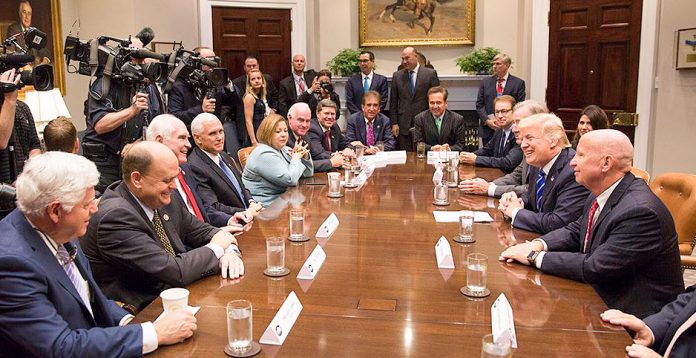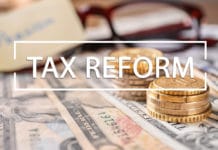
Published in E&E News
President Trump launched his bid yesterday to define his presidency with steep cuts in taxes and simplified tax rules, but left key details to a splintered Congress.
Whatever lobbying struggles lie ahead, mainstream energy organizations set aside legislative rivalries yesterday to offer early support for the tax framework announced by the president and Republican tax committee chiefs.
“Creating jobs, growing the economy and spurring investment in the U.S. through pro-growth tax reform is something everyone can support,” said Jack Gerard, chief executive of the American Petroleum Institute.
“The single most important action lawmakers can do to grow our economy and to create jobs is to pass comprehensive tax reform this year,” said Tom Kuhn, president of the Edison Electric Institute.
Trump needs a win, political analysts say, following the latest collapse of the Republican “repeal and replace” campaign against President Obama’s health care law, fallout from the crisis in Puerto Rico and a political embarrassment in an Alabama Senate race. And Trump faces a debate over whether tax breaks for the wealthiest Americans exceed those for his middle-income base of supporters and whether deficits from the cuts of as much as $2 trillion over a decade, by some estimates, would drag down or support his promise of faster economic and job growth.
“This is a revolutionary change, and the biggest winners will be middle-class workers as jobs start pouring into our country, as companies start competing for American labor and as wages continue to grow,” Trump said, speaking to supporters at the Indiana State Fairgrounds.
Trump’s plan would cut the corporate tax rate to 20 percent from 35 percent, rather than the 15 percent rate he had called for. At the same time, the plan would eliminate current tax credits except for deductions for charitable contributions and low-income housing. That provision would zero out long-standing tax benefits for oil and gas drilling, and potentially affect tax credits for wind and solar power installations that Congress renewed in 2015 with phaseout periods.
Killing tax preferences would make the corporate cut significantly less generous, tax experts noted, but the administration left that fine print to Congress, saying that tax committees “may decide to retain some other business credits to the extent budgetary limitations allow.”
The Trump plan would give the investor-owned utility industry work to do in trying to preserve the deduction for interest — costs that its members receive on their debt — a vital source of investment funds for power plants, transmission lines and other capital projects.
“We as an industry are really excited at the opportunity to try to get tax reform over the finish line,” said Eric Grey, EEI’s director of government relations. But he added, “There’s not a whole lot of detail, especially on the issues that are of importance to us.”
Outlook for renewables
While the elimination of the deduction for interest expenses is balanced in the plan by allowing business to immediately write off — or expense — investments (other than structures) for five years, that trade-off does not work ideally for power utilities, Grey said, because of their reliance on borrowing for investment capital to a much larger degree than other businesses.
“We are hands down the most capital-intensive industry in this country,” Grey said, with $125 billion in capital investments last year. Under current tax rules, utilities spread out the interest deduction over the long life of power plants and other equipment, which works to lower customers’ rates, he said. The proposed shift to immediate write-offs would raise utilities’ costs of borrowing, he said.
“It’s a timing issue,” he said. “In the next several weeks, we’ll spend a lot of time educating Congress.”
The White House did not respond to a question about whether the plan seeks to change the production and investment tax credits now in the law for renewable energy projects.
Keith Martin, a tax attorney with Norton Rose Fulbright, said he would not draw conclusions about the outlook for renewable tax credits based on the framework Trump issued yesterday.
“This plan is still lacking a lot of detail. Nothing is decided until the bills move to the floor” — if they do, he said.
Congress’ action in 2015 to extend and phase out the renewable credits was a pivotal part of a deal Democrats required to agree to Republicans’ desire to remove a long-standing ban on U.S. crude oil exports, and thus the credits have staying power. Fundamentally, Congress doesn’t want to offer a tax benefit and then pull it away from those who acted in reliance on the benefit, he added.
The tax plan could be a setback for renewable on another front, Martin said, if it reduces the amount of tax equity financing for wind and solar projects. Renewable energy developers typically can’t use all of the tax credit benefits directly themselves, so they barter them in deals with banks and insurance companies that can utilize the credits. The shift to expensing could reduce the appeal of the barter approach, obliging renewable developers to seek more costly financing.
Pinar Cebi Wilber, chief economist at the American Council for Capital Formation, praised the Trump proposal to change how the foreign earnings of U.S. companies are taxed, which puts them at a disadvantage against foreign rivals. Now, American companies are charged taxes in this country on the foreign earnings, on top of the tax payments owed the host government, and the United States is the only major industrial nation with that requirement, she said.
MLPs and returning foreign profits
The tax plan would exempt offshore foreign profits from U.S. tax when they are brought back to the United States, as an incentive to put that capital to work in this country, the administration says.
This revision would be a boon for some U.S. companies, including technology and pharmaceutical firms, but perhaps not as valuable for U.S. oil multinationals, which tend to plow foreign earnings into overseas development and often operate in higher-tax countries, Wilber said.
Trump proposed a new 25 percent tax rate for “pass-through” business, including partnerships and sole proprietorships that now pay taxes at their owners’ individual tax rate. The largest enterprises in this category are now subject to the top 39.6 percent marginal individual tax rate and would be big winners if the lower rate were enacted.
“The benefits from a maximum tax rate on pass-through business income thus skew enormously to people with high incomes,” said Donald Marron, a fellow with the Urban-Brookings Tax Policy Center. The administration called for restrictions, not yet defined, intended to prevent wealthy individuals from gaming the system by portraying personal income as pass-through business income. The framework also proposes to eliminate the estate tax, but Trump said yesterday, “I think there’s very little benefit for people of wealth” in the plan.
The pass-through category includes master limited partnership entities that have been the most important source of financing for oil and gas pipelines, particularly during the boom of shale oil and gas development.
Steep cuts in the corporate rate could conceivably make corporate financing of energy infrastructure more attractive to investors than the MLP model, potentially hurting the value of MLPs, which are traded on financial markets, said Sandy Fielden, director of research for commodities and energy at Morningstar Inc.
But he added, “It’s a pretty complicated calculation to figure out the pros and cons of. It could vary by circumstances.”
Martin said he sees the Trump plan as advancing the outlook for major tax changes, “but not by that much.”
“Congress has to solve the budget first,” Martin said. “They have to decide to what extent this [the tax legislation] will be revenue-neutral. They have huge demands for hurricane relief. The national debt has hit $20 trillion. And they have defense needs if we’re moving onto a potential war footing with North Korea. So how much room is there to cut taxes?”
ClearView Energy Partners was among the doubters, as well, in a commentary yesterday. Tax cuts are popular, but changes in tax structure, such as the proposal on foreign taxation, are something else.
“The predominantly regional and resource-based (rather than partisan) nature of U.S. energy policy seems likely to make reforming energy tax provisions even harder still,” the analysts said. “As such, we give structural reform no more than 20 percent odds of success.”






